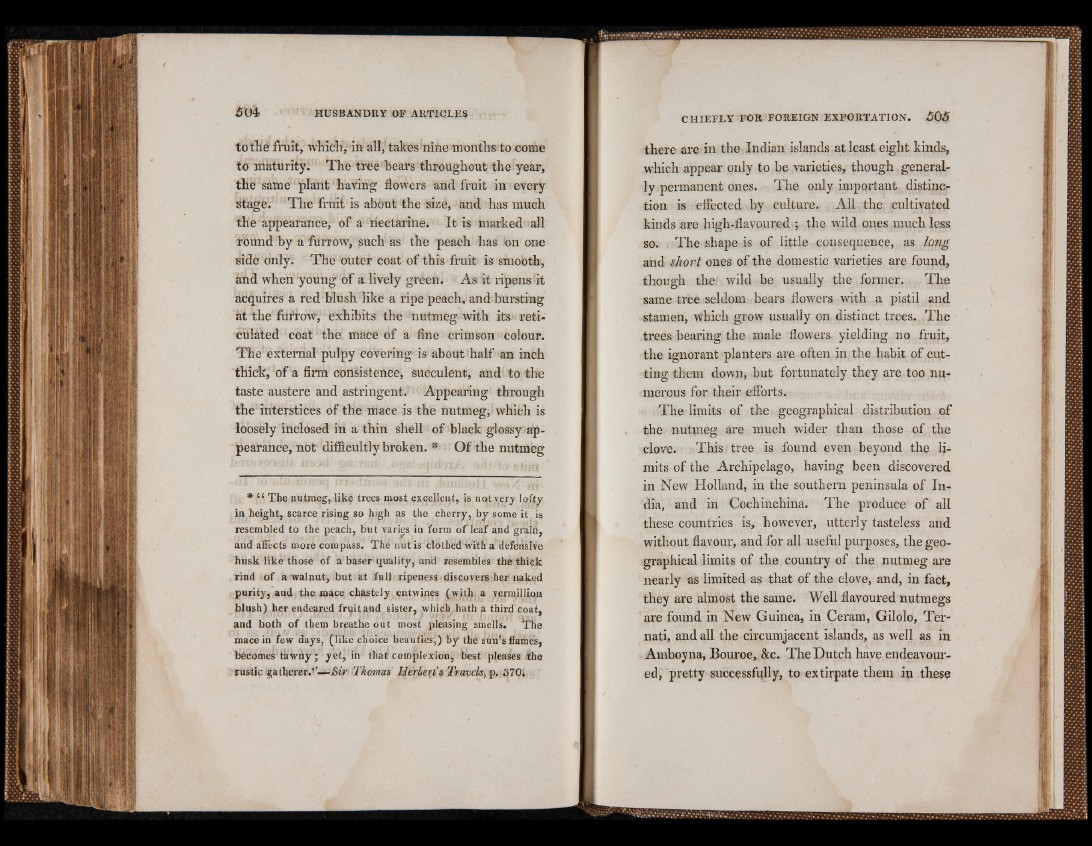
to the fruit, which , in all, takes nifie months to come
to niatu rity. The tree bears throughout the year,
the same plant having flowers and fruit in every
stage. The fruit is about the size, and has much
the appearance, of a nectarine. It is marked all
round by a furrow, such as the peach has on one
side only. The outer coat of this fruit is smooth,
and when young of a lively green. As it ripens it
acquires a red blush like a ripe peach, and bursting
at the furrow, exhibits the nutmeg with its reticulated
coat the mace of a fine crimson colour.
The! external pulpy covering* is about half an inch
thick, of a firm consistence, succulent, and to the
taste austere and astringent. Appearing through
the interstices of the mace is the nutmeg, which is
loosely inclosed in a thin shell of black glossy appearance,
not difficultly broken. * Of the nutmeg
* i£ The nutmeg, like trees most excellent, is nqtvery lofty
in height, scarce rising so high as the cherry, by some it is
resembled to the peach, but varies in form of leaf and grain,
and affects more compass. The nut is clothed with adeferi&ive
husk like those of a baser quality, and resembles the thick
rind of a walnut, but at full ripeness discovers her naked
purity, and the mace chastely entwines (with a vermillion
blush) her endeared frqit and sister, which, hath a third coat,
and both of them breathe out most pleasing smells. The
mace in few days, (like choice beauties,1) by the sun’s flaihes,
becomes tatvny; yet, in that complexion, best pleases the
Rustic gatherer.1’—-Sir Thomas Herbert's Travels, p. 370,
there are in the Indian islands at least eight kinds,
which appear only to be varieties, though generally
permanent ones. The only important distinction
is effected by culture. All the cultivated
kinds are high-flavoured ; the wild ones much less
so. The shape is of little consequence, as lo7ig
and short ones of the domestic varieties are found,
though the wild be usually the former. The
same tree seldom bears flowers with a pistil and
stamen, which grow usually on distinct trees. The
trees bearing the male flowers yielding no fruit,
the ignorant planters are often in the habit of cutting
them down, but fortunately they are too numerous
for their efforts.
The limits of the geographical distribution of
the nutmeg are much wider than those of the
clove. This tree is found even beyond the limits
of the Archipelago, having been discovered
in New Holland, in the southern peninsula of India,
and in Coch inchina. The produce of all
these countries is, however, utterly tasteless and
without flavour, and for all useful purposes, the geographical
limits of the country of the nutmeg are
nearly as limited as that of the clove, and, in fact,
they are almost the same. Well flavoured nutmegs
are found in New Guinea, in Ceram, Gilolo, Ter-
nati, and all the circumjacent islands, as well as in
Amboyna, Bouroe, &c. The Dutch have endeavoured,
pretty successfully, to extirpate them in these